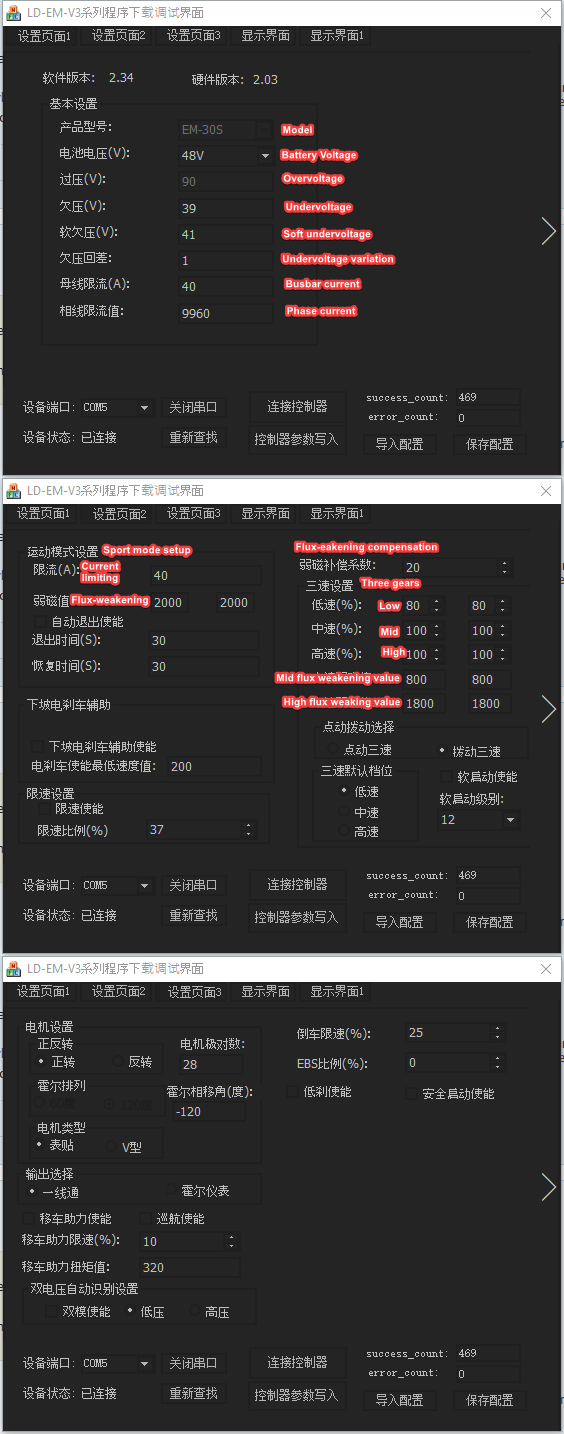Hello everyone,
I have Xiaoniu U1 Pro e-scooter and I have replaced original controller with VOTOL EM-30S.
Currently my hardware set up as follows:
Engine: 800W
Battery: 48V40.3AH (54.6V max. charging voltage, 39V min. charge voltage, 45 A max. discharging current, 12 A max. charging current)
Controller: VOTOL EM-30S
I'm not a techy guy and do not know much about deep modification of e-bikes, as well as electric circuits. Originally a seller of the controller helped me to set up all the data. I use e-bike to get to work and back home, the route/distance is the same each day. Originally, when I have just bought the battery, about 7 months ago, I was able to use one charge for 3 days, but recently I'm experiencing an issue when my e-bike forcefully cuts the power off when there are still 20-22% of battery charge. I have changed Undervoltage & Soft undervoltage to 39V and 41V (originally: 41V and 42V), and both Busbar current & Current limiting to 40A (originally: 45A both). But it didn't solved the problem of force power cut with 20-22% battery charge.
So I have two questions:
1. What I should change in present controller settings (see the current data on the image below. I do not have English version of the flash app, but I can help with Chinese translation if needed), any way to optimize them?
2. What could be an issue that there is a force power cut when still 20-22% battery charge left, while at the very beginning I was able to ride on one charge during 3 days and use the battery up to 0%? (need to mention that most of the times I charge the battery on the second day, when there are still 40-45% of charge left. There were like 3-4 times when I ride on one charge till 0%).
Any help would be really appreciated.

I have Xiaoniu U1 Pro e-scooter and I have replaced original controller with VOTOL EM-30S.
Currently my hardware set up as follows:
Engine: 800W
Battery: 48V40.3AH (54.6V max. charging voltage, 39V min. charge voltage, 45 A max. discharging current, 12 A max. charging current)
Controller: VOTOL EM-30S
I'm not a techy guy and do not know much about deep modification of e-bikes, as well as electric circuits. Originally a seller of the controller helped me to set up all the data. I use e-bike to get to work and back home, the route/distance is the same each day. Originally, when I have just bought the battery, about 7 months ago, I was able to use one charge for 3 days, but recently I'm experiencing an issue when my e-bike forcefully cuts the power off when there are still 20-22% of battery charge. I have changed Undervoltage & Soft undervoltage to 39V and 41V (originally: 41V and 42V), and both Busbar current & Current limiting to 40A (originally: 45A both). But it didn't solved the problem of force power cut with 20-22% battery charge.
So I have two questions:
1. What I should change in present controller settings (see the current data on the image below. I do not have English version of the flash app, but I can help with Chinese translation if needed), any way to optimize them?
2. What could be an issue that there is a force power cut when still 20-22% battery charge left, while at the very beginning I was able to ride on one charge during 3 days and use the battery up to 0%? (need to mention that most of the times I charge the battery on the second day, when there are still 40-45% of charge left. There were like 3-4 times when I ride on one charge till 0%).
Any help would be really appreciated.


